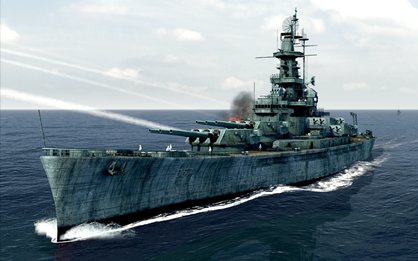Battlestations: Pacific
Boat-on-boat action
A dozen Japanese jets, B-17s, and dive bombers are spilling shells and rockets into the ocean like jackpotting slot machines, and I’m calmly thumbing my gamepad, fending off waves of Kamikaze with a single anti-air turret. A tap of the d-pad and I’m in the cockpit of a Corsair fighter, barrel-rolling into a strafing run on a Japanese destroyer to swiss cheese its artillery guns. Another d-pad push and I’m steering a battleship to lob artillery rounds at an enemy bomber hangar.

For all its tactical complexity, the ease of playing Battlestations: Pacific makes managing a fleet of WWII warships and squads of fighter planes a smooth process. Juggling destroyers, bombers, and recon planes shouldn’t be this simple, but seamlessly hopping between manually dropping bombs from a plane, repairing an aircraft carrier, and switching to the RTS-lite strategy mode makes it easy to transition between roles.
With Pacific, Eidos Hungary is iterating on the hybrid gameplay it got mostly right in Battlestations: Midway. “Combining strategy with hands-on play puts the player right in the middle of the action, creating a personal connection because players control multiple ‘stations’ that they can switch between instantly as they see fit,” says Lead Designer Botond Szalacsi. “We want large-scale air and sea battles to feel truly epic, where the player feels the risks and rewards they’re taking first-hand.”
Pacific’s unit count outnumbers Midway’s by 20 (for a total of 100) and adds a completely new two-faction campaign. Of the added planes and boats, catapult-launching recon planes and Kamikaze are the most eye-catching; each adds brand-new mechanics for scouting and attacking. In Midway’s single-player, a fictional narrative piggybacked to the story of an American officer to tie plot threads between Pearl Harbor and Midway, but Eidos is taking a different approach to Pacific. “The story of the original game limited us in many ways,” Szalacsi admits. “This time we decided to not use a character to narrate the story. So the answer was to not assign an imaginary role to the player, but to allow the player to experience the whole war and its battles by playing many roles amongst the largest battles in human history.”

Being able to play as Americans and Japanese alike is a bonus for WWII buffs looking to re-create history. For those looking to rewrite it, you’ll encounter history-revising missions in the campaign like the Battle of Coral Sea. The conflict was a stalemate in reality, but if you’re able to overcome the Americans, you’ll shift the conflict to Port Morsby, which historians claim would’ve been the next attack in the Japanese plan to control the Pacific. “We wanted to give players a different point of view, not just another campaign with different units, and we felt that it’s important to really win the war as the Japanese - there is no point in winning a game, and losing the war itself,” Szalacsi notes.
Weekly digests, tales from the communities you love, and more


